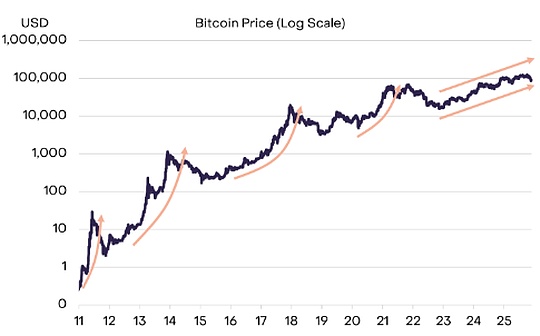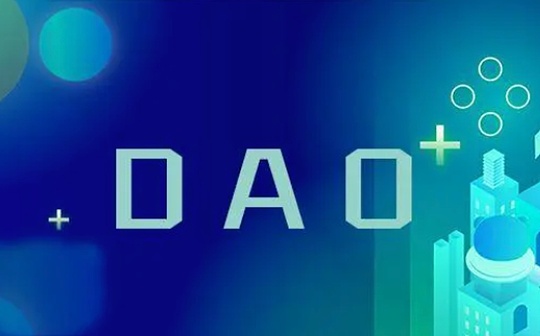
With the development of decentralized autonomous organizations (DAOs), their governance risks are gradually emerging.Traditional decentralized measurements are difficult to reveal the threat of secret manipulations such as Dark DAO.VBE (Voting Bloc Entropy) is an innovative indicator that quantitatively evaluates the degree of centralization of DAO through clustering and entropy calculations, revealing potential risks to manage.This article will briefly explore the core framework of VBE and its practical application in DAO governance.
01 Background Introduction
A few months ago, Compound DAO passed Proposal 289, a typical governance attack, where five addresses exploited Compound DAO’s governance vulnerability to steal 5% of the control of the community’s vault: approximately $24 million in assets, Through this proposal, control will be handed over to a community that is completely uncontrollable and multi-signed wallet.
Before this incident, the existing decentralized indicators failed to clarify the expected risks. The popular analytical indicators are actually relatively backward. For example, the Satoshi Nakamoto coefficient and Gini coefficient are both different by tokens.The distribution of addresses is centered on the analysis, which obviously ignores the hidden connections behind the addresses and the existence of Dark DAO, a general term that describes a decentralized alliance that manipulates voting on the chain through opaque means (such as bribery).
So how do we penetrate the address information on the surface, reveal the cluster connection relationship behind the address, and dig out hidden risks?Among the three words DAO, the most important but difficult to quantify and analyze is the first word: D (Decentralization, decentralization), https://www.initc3.org/ Posted a try to pull out the address group behindThe indicator of “hidden alliance” is VBE (Voting Bloc Entropy,Voting Collective Entropy), focusing on the following three core concepts:
-
Voting: Voting behavior and decision-making model.
-
Bloc (Block/Area of Interest): In VBE, Bloc refers to a group of voters who behave highly similarly, regardless of whether these addresses belong to the same entity or are publicly associated.
-
Entropy: Entropy is a concept used to measure uncertainty or distribution uniformity in a system, which VBE uses to evaluate the concentration and power distribution of voting blocks.
-
High entropy: Voting behavior is scattered, multiple voting blocks have different views on proposals, and governance is more decentralized.
-
Low entropy: voting behavior is concentrated, a few blocks control the results of proposals, and governance is easily manipulated.
It is worth mentioning that VBE is also pronounced as “vibe”, symbolizing the atmosphere of the community – an abstract but crucial trait.
Core principle of VBE: Consistency of interests among voters in multiple proposals (i.e. forming a voting group) is a centralized manifestation.VBE measures the degree of centralization of DAO organizations by clustering participants with similar utility functions in multiple votes and calculating entropy values.
So how does VBE penetrate and analyze, and how does the abstract community “vibe” quantify into concrete indicators?Let’s jump into the rabbit hole to find out!
02 VBE: Voting Bloc Entropy
The VBE framework can be split into two key parts:Clustering Metric and Entropy.The following are its key content and implementation methods:
1. Clustering
VBE defines ?-threshold ordinal clustering, ?-TOC, the rules are as follows:

Formula interpretation:
-
The goal of this formula isDetermine whether the voting behaviors of two token holders are similar, thus grouping them into a group (cluster).Specifically, it defines “similarity” through the following two conditions:
-
Clustering Condition 1 (the tendency to vote is consistent): A simple example is: if two people support (positive) or both oppose (negative) in a certain election, that is, their voting symbols are the same, they are considered to be in this electionConsistent behavior in .

-
Clustering Condition 2 (the preference difference is small enough): A simple example is: Even if two people have different symbols in a certain election, their preference intensity differences (such as the degree of support and objection) are small enough (less than the set threshold ϵ) , they can also be considered to behave similarly

-
UEP (see formula below): Address Pi’s preference effect on election set E
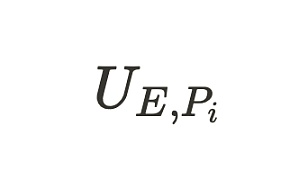
-
k: election index, indicating the kth election
-
ϵ: Threshold, used to measure whether the intensity difference is negligible
Although finer-grained measures can be clustered based on the cardinal Utility, ordinal equivalents have effectively indicated preference consistency.
?-TOC can be calculated based on historical voting data.
Special treatment of indifferent voters: Also classified indifferent voters who are validly used close to 0 are a further category, marked A’.These voters have little interest in the election results, and their voting behavior reflects low participation in governance.
2. Entropy (Entropy)
VBE uses minimum entropy (min-entropy) as the measure of entropy.The formula is as follows:

Interpretation of formulas
-
A: Represents all addresses (sets).
-
tokens(A’): Indicates the number of tokens held by address (set) A′.
-
maxA′∈A: Indicates the maximum value of the token holding in all addresses (sets).
-
T: Indicates the total amount of tokens held by all addresses.
Entropy is used here to measure the “information amount” of token distribution, but it focuses on the contribution of the largest token holders (or groups).A greater concentration means lower entropy (less information).
Fineer-grained entropy (such as Shannon entropy) can be used for more complex analysis, but is difficult to actually estimate and has high computational cost.
VBE instantiation formula
Combined with the above clustering and entropy definitions, for the election set E, the player set P and its corresponding effects U(E,P), the token distribution function tokens, the clustering metric C and the entropy function F, the specific instantiation formula of VBE is:

VBE Core Theorem
The VBE core theorem provides a general framework for analyzing how system changes affect the degree of decentralization.The basic logic of core theorem analysis is:
-
Comparing the two systems, the only difference between them is some kind of “transformation” T, such as increasing voter indifference and elections to private mode.
-
The effect of this transformation on the largest voting block in the two systems is studied.
-
Based on this change, the VBE of the two systems is calculated and compared.
In the VBE core theorem, let T be a function that changes the player set, election set, player utility and/or token distribution, and is defined as:

Among them, the total amount of tokens in the system remains unchanged.
Let B and B′ be the original system (E, UE, P, tokens) and the transformed system (E′, UE′, P′, tokens’), respectively, and the tokens clustered by ϵ-TOC are held.The voting block with the largest number meets the following conditions:

-
tokens(B): represents the ratio of tokens held by the largest voting block B, which is used as weight in the entropy metric.
-
As the proportion of tokens held by B’ increases, the relative entropy value of B decreases, resulting in an increase in VBE.
-
If B′ forms a new governance advantage (i.e., majority control is obtained by B′, majority by token holdings), then VBE will be strictly increased; if the token ratio remains unchanged, then VBE is equal.
This core theorem provides a paradigm for subsequent specific theorems, just:
-
Defines a system transformation T and describes how it modifies the maximum voting block.
-
Derived through the core theorem, the effect of the transformation on the VBE value is evaluated, thereby quantifying the change in the degree of system decentralization.
Extended analysis application of core theorem
(In the examples mentioned in this section, the detailed derivation and proof are in chapters 3.2~3.8 of the paper at the end of the article. Please follow the details if you are interested)
1.Witch Attack
-
VBE can effectively identify multiple accounts controlled by a single entity and treat them as a single voting block.
-
Even if whales “disguised” decentralization through account decentralization strategies, VBE can still reveal the true degree of centralization of the system.
In contrast, metrics based solely on account balances may mistakenly assume that the degree of decentralization of the system is increased, as these methods ignore the true distribution of control of tokens.
2.Control indifference
Centralization effect:
-
The massive emergence of indifferent voters will lead to a concentration of voting rights in a larger unified block.
-
This suggests that indifference may lead to a more centralized system power structure in practice.
“Indifference Whale” phenomenon:
-
A collection of indifferent voters can be regarded as an “inactivity whale” whose behavior has potential systemic importance.
-
Even if they don’t vote, the amount of tokens held by this group may significantly affect the system’s decentralization.
3.Delegation Voting (Delegation)
Intuitively, commissioned voting seems to make the system more centralized: tokens originally held by a large number of players are transferred to a small number of representatives.However, through the analysis of VBE, this situation is actually more complicated.Delegated voting often makes DAO more decentralized:
-
In the case of high indifference: Delegated voting is the most effective because it disperses the tokens of “Indifference Whale” into multiple representative blocks, reducing the risk of centralization of the system.
-
Need to pay attention: If a new “whale” is formed itself, the degree of decentralization of the system may decrease.
4.Herding effect
The core goal of DAO and other democratic systems is to have token holders vote based on real preferences, but the herd effect, such as the alliance behavior triggered by public voting, often hinders this goal.Token holders may be forced to follow influential members due to reputational risks, or be consistent with their peers, forming large voting entities.This social effect causes votes to deviate from personal real expectations, leading to intensifying centralization.Despite the uniform distribution of tokens, traditional metrics may misjudgment the system as decentralized if the group effect prompts everyone to support the same result.And VBE can reveal how reputation risks strengthen centralization and reflect the real level of decentralization:
-
The importance of privacy: The protection of voting privacy helps to alleviate the centralization pressure brought by the herd effect, thereby enhancing the decentralization of the system.
-
The universality of the herd effect: In DAO design, the herd effect is a common phenomenon that can lead to system inequalities and inefficiencies.Therefore, design needs to consider how to reduce the impact of social dynamics on voting behavior.
5.Voting Slates
Voting groups are often used to “hide” some unpopular proposals in a large number of popular, harmless proposals, thereby increasing the possibility of these unpopular proposals being passed.VBE reflects that bundling proposals does reduce decentralization: by considering narrower election sets, thus smoothing the utility function, different voting blocks are merged into larger voting blocks.
-
How to deal with it: To remain decentralized, voting groups should be used with caution, especially when dealing with elections with distinctly different preferences.
6.bribery(Bribery)
There is an intuitive relationship between election bribery and decentralization, that is, successful election bribery threatens decentralization: in this case, the entity that obtains votes from other players now controls a higher proportion of tokens than before.However, traditional decentralized measures (based on the distribution of tokens in the account) fail to capture this: voters who are voted by bribes, while voted as directed by the bribes, still technically hold their tokens.Instead, VBE classifies all bribes into the bribe’s voting block, because the utility functions of these bribes are now aligned with the expected results of the bribe.Interestingly, like the analysis of governance indifference, election bribery can lead to a reverse intuition: that election bribery can lead to a more decentralized system, especially when it destroys a larger voting block (e.g.a lazy whale block or some big voter alliance).But here we ignore this marginal situation, assuming that the vote blocks that are voted for bribes represent the majority calculated by token holdings.Therefore, although election bribery does not necessarily increase centralization unconditionally, it poses a practical threat to decentralization.
-
Successful election bribery must be systematic, i.e., large amounts of tokens must be involved, which only happens when the system is highly decentralized.Intuitively speaking, if a DAO is highly centralized, the briber can directly coordinate with several big players to ensure the election results; or, if the briber is a whale (holding a large number of tokens), you only need to bribe a few small players.Accumulate enough tokens to launch a successful attack.Instead, in a more decentralized system, players are smaller, so voters need to expand their attacks if they want to win the election.That is, in this case, successful election bribery requires large-scale coordination among multiple small players.
7.Square fundraising method(Quadratic Voting, QV)
QV tried to weaken whales, but could unintentionally expand the influence of election bribery:
-
If there are enough uninspired “little players” in the community, voters can manipulate election results at a lower cost, because QV will amplify the influence of “little players”.
Witch Attack Risk: If the system lacks real identity verification, whales can spread tokens across multiple accounts, bypassing QV’s impact penalty on whales, thereby increasing the total voting weight.This actually weakens decentralization.
VBE can be used to identify implicit voting blocks in QV, thereby more accurately evaluating the degree of decentralization of governance.
Limitations of VBE
-
Comparative Questions:VBE is a framework that cannot directly compare results between different VBE instances or variants.Therefore, to analyze the change in the degree of decentralization, it needs to be evaluated under the same VBE parameters.
-
Limitations of VBECe,min: Focus on the largest voting block and ignore the contribution of small voting blocks.This may lead to incomplete results in diverse scenarios, and other entropy measures (such as Shannon entropy) may provide a more complete perspective.
-
Strictness of clustering metrics: The current ϵ-TOC clustering method only considers exactly the same choice, which may be too strict.ϵ\epsilon, a more relaxed clustering method (such as clustering based on partial consistency) can provide more granular analysis, but also increase computational complexity.
03 Dark DAOs
Dark DAO itself is a decentralized organization with the goal ofIntervene in other DAOs’ voting decision-making processes to subvert(subvert) The existing decentralized credential systemAs we mentioned earlier, malicious behavior will be carried out in the form of giant whale cooperation in the case of centralization. As the degree of decentralization of DAO increases, the cost of bribers (large players) will increase, and bribers need to conduct a wider range ofCoordinate, as more users must be targeted, Dark DAO threat thus increases.
Similar to ordinary DAO, the design goal of Dark DAO is to achieveMinimize trust: It ensures that bribes are “fair”, that is, the bribe recipient will receive remuneration only if the bribe gains access to the credentials agreed to by the bribe recipient.In addition, Dark DAO is “opacity”, meaning that the participation process is private.
Dark DAO has the following three key properties:
-
Opacity: Dark DAO participants cannot be distinguished by other credential holders on the chain, and their participation scale and number of people are completely hidden.
-
Fair exchange: The payment of bribes is conditional.The bribery recipient can only receive remuneration after the briber successfully obtains vote support from the bribery recipient.
-
Limited range: The recipients of bribery participating in Dark DAO will not contribute any resources to Dark DAO except for the promised vouchers and pre-agreed costs.(For example, the bribery recipient may also have to pay normal transaction fees.)
Dark DAO’s goal
Dark DAO’s goal is to undermine the voting decisions of the target DAO.The following are the main implementation methods:
1.Vote buying
Dark DAO achieves goals through bribery, such as paying token holders to vote for a specific result.
Payment methods can be conditional, such as payment only after the result is reached or a fixed remuneration is distributed according to the total number of votes.
Not only will token weight voting be affected, but even “one vote per person” systems such as Gitcoin Passport or Worldcoin may be abused by using keys or identity credentials for election bribery.
Dark DAO can greatly reduce the cost of bribery, such as through the “pivotal bribery” strategy: only pay the main compensation to key voters who change the results, and other participants pay only very low fees, thereby changing the vote at a very small price.result.
2. Coordinated price manipulation
Dark DAO is not only limited to the distribution of bribes, but also indirectly reward participants through collective action.
For example:
-
Participants collectively establish short positions for target assets;
-
Voting drives the result that leads to a decline in asset prices;
-
Distribute the profit after closing the position and making a profit.
This approach may also extend to consensus protocol attacks or market manipulation.
3. Undermining perceived election integrity
-
The existence of Dark DAO itself may raise suspicion about the DAO election.
-
Even if Dark DAO is limited in participation, it may affect the community’s trust in elections by hiding scale or selective disclosure of participation (such as holding at least 10% of tokens).
4.Exploiting quadratic voting and quadratic funding
-
Dark DAO can evade QV restrictions using address segmentation.For example, by distributing tokens to multiple addresses, voting weight is increased.
-
Even with a decentralized authentication system, Dark DAO can still manipulate results by “temporarily distributing tokens to other users and controlling their voting behavior.
-
Similar means can also be used in QF to manipulate fund allocation.
5.Subverting privacy pools
-
The privacy pool is designed to balance privacy with compliance, but Dark DAO can undermine this mechanism through identity trading.
-
For example: a compliant user can rent out his compliant identity through Dark DAO, allowing non-compliant users to temporarily use their address to launder money or evade sanctions.
-
On the other hand, Dark DAO can also reversely enhance the security of the privacy pool, such as requiring addresses to maintain a minimum balance, thereby limiting the weakening or disintegration of the privacy pool.
Extended: A Dark DAO instance framework
(The part about the Dark DAO example framework is in the original paper at the end of the article 6. Basic Dark DAO and 7. Dark DAO Lite. If you are interested, please follow the details)
Github_DarkDao
https://github.com/DAO-Decentralization/dark-dao
This Dark DAO framework demonstrates how to use Web3 technology to complete complex transactions and coordination under completely anonymous conditions.
-
In addition to buying tickets, the Dark DAO framework can also adapt to more complex market manipulation and privacy management needs.For example, users can use this framework forPrice control, achieve indirect market profits by setting collective action goals (such as shorting assets) and result-driven reward rules.In addition, the framework can also be used for privacy pool attacks, helping to rent compliant identities and indirectly undermine the balance between privacy and compliance.
The paper also proposes a lighter Dark DAO Lite variant, which simplifies the complete anonymity of Dark DAO to limited anonymity, simplifying the process of trustless collaboration.Dark DAO Lite can achieve limited privacy protection through decentralized authentication systems such as Gitcoin Passport or Worldcoin combined with zero-knowledge proof while ensuring that each user’s voting rights are calculated fairly.This design will reduce the cost of attack implementation, increase the concealment of attacks, make it more flexible, and more difficult to detect and prevent.
So whether it is the Dark DAO or the Lite version, its privacy and efficiency are enough to pose a fatal threat to the decentralized system.For example:
-
Governance transparency weakens: Dark DAO can undermine public trust in the governance process, especially when its size and objectives are unclear.
-
System fragility: The technical complexity of Dark DAO increases the attack surface of the protocol itself, such as tampering with rules or allocation mechanisms through malicious smart contracts.
04 Observe DAOs with VBE
The previous article summarizes the indicator characteristics of VBE and the characteristics of Dark DAO. The following is an application of VBE indicators when observing DAO, a DAO oVBE Dashboard. The following is a detailed introduction to this dashboard:
https://public.tableau.com/app/profile/daovbe/viz/DAOoVBEDashboard/Voting-BlocEntropyOverview
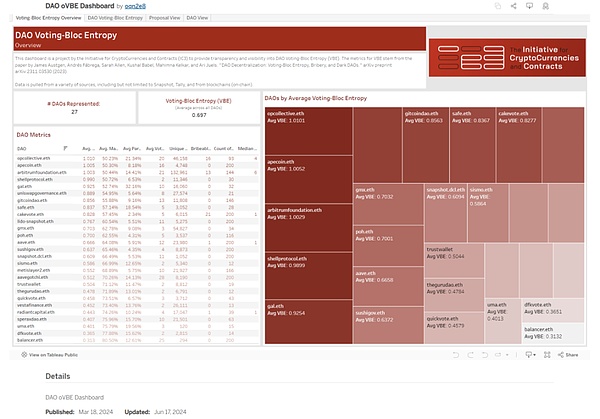
Overview: Voting-Bloc Entropy Overview
Overview: Voting-Bloc In the overview of the home page, we can see that this dashboard contains 27 DAOs VBE data and sorts the chart on the right: Entropy Overview
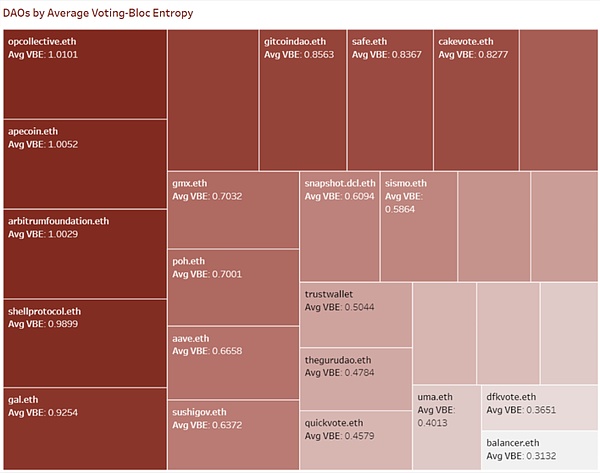
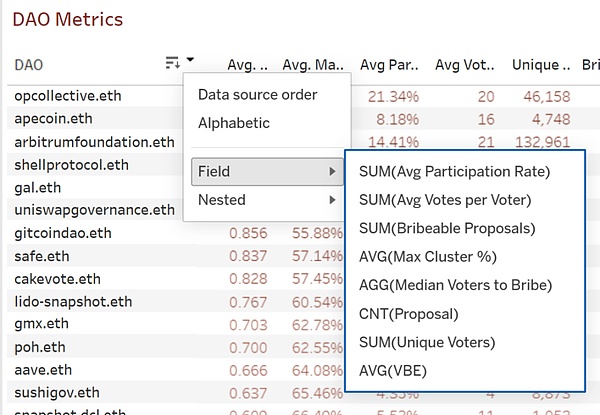
In Dashboard Overview, we can see these eight parameters:
-
AVG(VBE): refers to the average of the VBE values in the entire statistical time period.(IC3 official prompts to pay attention to the cross-DAO comparison of VBE parameters)
-
SUM(Avg Participation Rate): The sum of the average proportion of token holders participating in the vote in the vote.Used to measure overall activity and participation in voting.
-
SUM(Avg Votes per Voter): The sum of the average votes of all voters is used to measure the concentration of voting rights in the vote.
-
SUM(Bribeable Proposals): The sum of all possible manipulated proposals to measure potential corruption risks.
-
AVG(Max Cluster %): The average of the proportion of the largest voting blocks in all votes.This indicator reflects the concentration of the voting blocks, and the higher the concentration of the voting results, the more serious the concentration.
-
AGG(Median Voters to Bribe): In order to influence the voting results, an aggregate of the number of median voters who are “buyed”.
-
CNT(Proposal): Total number of proposals in DAO.
-
SUM(Unique Voters): The sum of all independent voters after all vote deduplication in the statistical time period is used to measure the diversity of participants and the coverage of DAO governance.
Double-click the specific parameters in the list, and we can also open the details to observe the changes in the data and the comparison between different DAOs:
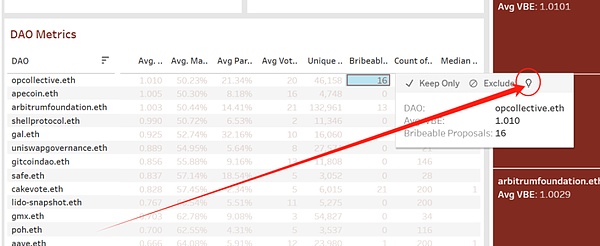
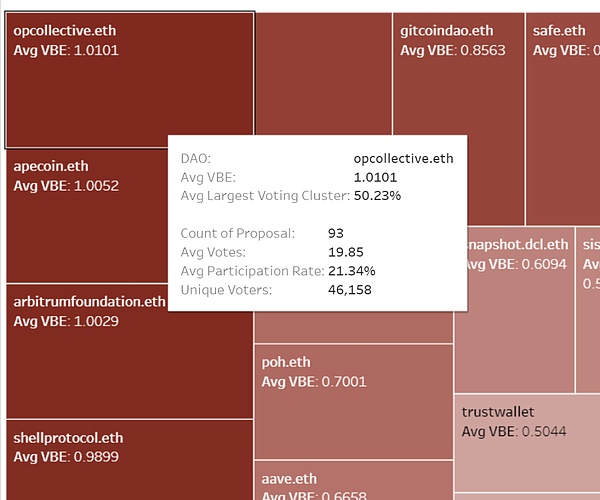
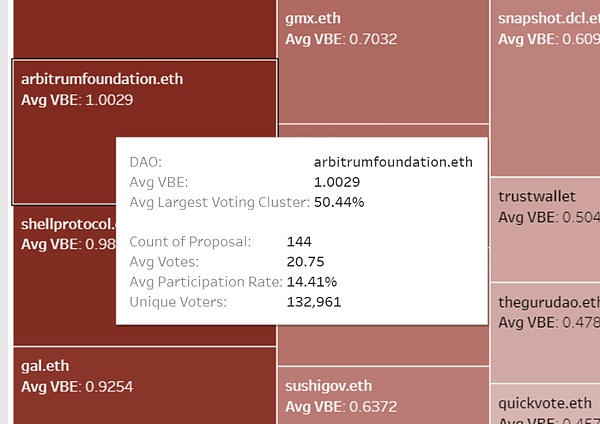
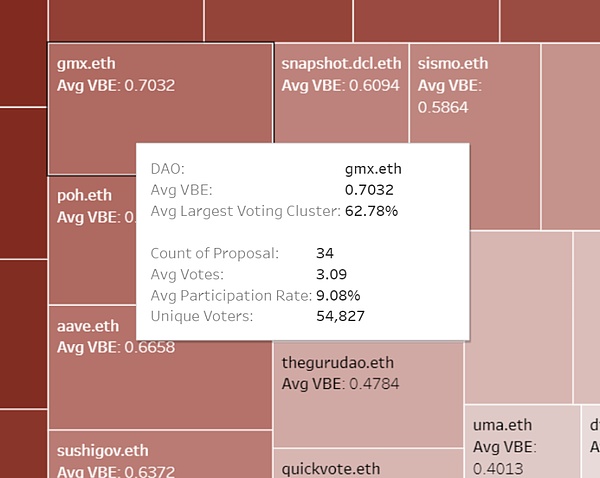
DAO Pagination Details

You can observe the details of each DAO in the page details. The chart in the upper left corner shows the VBE value and maximum voting cluster ratio of each time window (window) during the period.
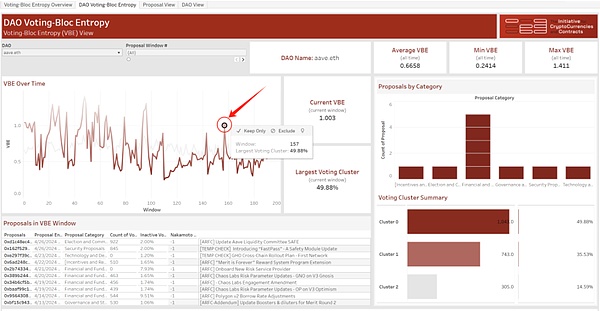
Click on the time point in the line chart. The upper right side will show the comparison of proposal categories in this window, the lower right side will show the voting cluster overview in this time window, and the lower left side will show the details of proposals in this time window.
-
VBE comparisons between different DAOs need to pay attention to the differences in the underlying data sets, but VBE changes and voting cluster changes within the same DAO are more intuitive ways to analyze the trend of changing degrees of decentralization of this DAO.
05 Cross-extension of VBE and DAO
Combining the framework of VBE and the analytical inferences of VBE on DAOs, there are several specific guiding principles for seeking to implement or improve meaningful decentralized DAOs:
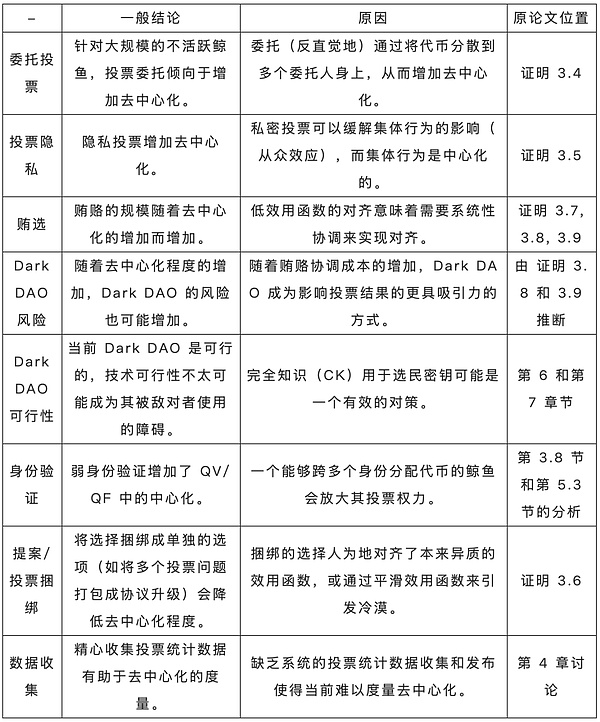
Extended thinking topics
VBE evaluates the degree of decentralization of DAOs by measuring the entropy of the voting group.In fact, VBE is a flexible framework that combines any required clustering method to identify groups, as well as any definition of entropy.
The following are open questions worthy of attention raised at the end of the paper:
-
Privacy and data collection:
How to collect enough data to facilitate VBE evaluation while ensuring voting privacy is a problem yet to be resolved.
-
DAO forking and escape mechanism:
DAOs may experience catastrophic failures, and how to study the impact of the use of DAO forking and escape mechanisms on decentralization is an important issue.
-
The impact of VBE on DAO decision-making:
Are high VBE values related to community growth, engagement, and financial performance?And how it is related to democratic participation in non-blockchain environments remains a direction worthy of research in the future.
06 Study summary
VBE is an in-depth exploration of the concept of “decentralization” in DAO, providing a new perspective, and quantitatively analyzes the essence of decentralization by focusing on the interests behind voting behavior and its degree of concentration.
We love DAO and hope that DAO can continue to develop healthily.In this paper, Dark DAO is discussed separately and takes up important space, just like the hidden order, Dark DAO has a lasting and unnegligible impact on the governance model of different DAOs.The existence of Dark DAO is not only inevitable, but also an important factor in shaping the future governance ecology.Therefore, DAO builders should learn to examine themselves from the perspective of Dark DAO, learn Dark DAO’s ideas and technologies, and explore strategies to coexist with it to achieve a more robust and inclusive governance system.




